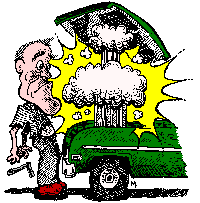|
MY
ENGINE IS SHOT!

DO I
REPLACE With New Car
REBUILD Engine
or
Install REMANUFACTURED Engine?
Does
it make economic sense to buy a New Car?
The average new car costs
around $20,000. In addition to your trade in, you'll have to make
monthly payments for 3 to 5 years
(and, of course, a
new car loses about 25% of its value the minute you drive it out of
the showroom).
Sure, you'll have a shiny
new car.
You get a new-car warranty.
Finance charges are expensive.
At 8%, you get socked for
$2,300 over 3 years.
Insurance costs will
probably go up.
You could lease a new car,
but you won't build up equity. With a $300/36 month lease, you'll
have nothing to show for your money after 3 years except $10,000
worth of receipts.
Excess mileage is costly.
Sales tax on a new or
leased car will hit you for $1,000 to $5,000 or more
(depending on where you live).
You may gain new options
like a CD player or sunroof.
Or
is it
smarter to install a Remanufactued Engine?
You can have a
remanufactured engine installed for between $1,800 and $2,500 (most
cars).
You save about $18,000
compared with buying a new car.
Your car will increase in
value and gain a zippy new lease on life.
Your engine should perform
"like new" for tens of thousands of miles.
Financing usually can be
arranged with low monthly payments.
With all the money
you save you can continue to save for a new car.
No increase in insurance.
Drive as many miles as you like!
Sales tax should be around $120
You can add whatever
accessories you need for far less than car dealers charge.
With its new engine, your
car will be worth more as a future trade-in or to sell or pass on to
family or friends.
You'll be doing your part
for the environment by having a recycled engine in your recycled and
renewed car.
Exploring the choices and
considering the pros and cons of trading in your vehicle, having a
new engine installed, overhauling the old engine
or
installing a remanufactured engine.
Trading in the vehicle for
a new one is like "throwing the baby out with the bath water".
The costly option of a new engine?
How about overhauling
the old one?
Also expensive, possibly
costing about the same as installing a remanufactured engine.
However, the
remanufactured engine would carry a strong factory warranty.
The remanufactured engine
would not only be as good as the original,
in several respects it
would be better.
When considering engine
replacement, you may have heard the terms "rebuilt"
and "remanufactured" and thought the terms referred
to the same process.
There are major differences
in engines that are rebuilt or remanufactured.
Typically, a rebuilt engine
will have a much shorter life than a remanufactured unit
because the process
is much less precise and therefore, less predictable.
Rebuilding is done
in local shops and depends upon the judgment and skill of the
individual mechanic. Parts believed to be serviceable are cleaned and
reused; only worn or broken parts are actually replaced. If reused
components subsequently fail or break, diagnosis and repair can be
very costly.
Remanufacturing is a
very exacting factory process where engine and component parts are
completely disassembled, thoroughly cleaned, carefully inspected, and
conditioned and machined to OEM tolerance specifications. The
finished engine is tested using state-of-the-art computerized equipment.
Remanufacturing is similar
to building a new engine; simple replacement of parts, or rebuilding,
will not result in the same high quality product that is produced by
the remanufacturing process.
How is it done?
The remanufacturing process
begins with a sound, undamaged engine "core" that is
dismantled to the smallest component and then carefully cleaned,
conditioned, and machined to OEM tolerance specifications. Each
reusable part is machined to original manufacturer tolerances.
Throughout the process, the parts are continuously inspected for
hidden damage and removed from the process if tolerances are not maintained.
The cleaned and
reconditioned or new parts are reassembled to what is known as the
"long block" assembly. The long block is the heart of the
engine and when installed, is connected to the other parts of the
vehicle, such as the exhaust, fuel systems, and electrical systems.
Among the new parts in a
quality remanufactured engine are piston and pins, piston rings,
connecting rod bearings, main and camshaft bearings, pushrods, the
timing gear and chain (where applicable), valve lifters,
gasket and seals, freeze plugs, and oil pumps. Valves, springs and
guides, along with crankshaft and connecting rods are either
remanufactured or replaced. Cylinder heads are cleaned and
resurfaced, cylinders are bored and valve seats are resurfaced.
Once assembled, a
remanufactured engine must also meet factory specifications during
oil pressure, compression, and vacuum testing.
If your vehicle is in good
shape but your engine isn't, replacing your engine with a
remanufactured one is probably the only way you will have "new
car" performance.
We recommend remanufactured
engines because they insure greater customer satisfaction than
rebuilding the old one. Not only is a quality remanufactured engine
restored to original specifications, due to improvements added by the
manufacturer the end product can be better than a new engine of the
same type.
If your present vehicle is
in good shape except for an ailing engine, replacing your engine is
probably your best bet. It doesn't matter how old or worn-out your
engine is. You can exchange a poorly running oil-gulping engine for a
carefully remanufactured engine that will deliver "new car" performance.
Many vehicle owners don't
realize that a renewed engine is assembled to perform as well or even
better than the original engine.
You'll
be helping the environment.
By purchasing a
"recycled engine," you'll be saving precious resources and
energy, while greatly extending the service life of your car and
its parts. |